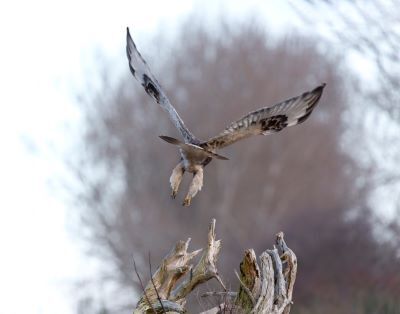
Good Natured: Rough-Legged Hawk
What's more fun than an up-close glimpse of a hawk? How about an up-close glimpse of a hawk species you've never seen before, practically in your own backyard?
That's exactly what happened to my friends Jenny and Jeff Risch just a week or so ago. Jenny, a self-proclaimed bird nerd, texted a screenshot with information about the rough-legged hawk, Buteo lagopus, along with a note that read, “Pretty sure Jeff and I saw this raptor at St. Charles North yesterday. We were freaking out. It was huge and like nothing I have ever seen."
Jenny went on to explain that the bird's breast was white dappled with dark, and did not have the markings of a red-tailed hawk or Cooper's hawk, two birds she's very familiar with. She also emphasized the bird's large size, which checks the box for roughlegs too. While these hawks actually are a little smaller than redtails, they have long wings and tails in relation to the size of their body, which makes them seem bigger than our “usual" species.
Although she wasn't able to snap any photos, Jenny's verbal description of the bird certainly matches a roughleg. So does the timing.
These are birds that breed in the Arctic, in places so far north they make Illinois seem like Miami Beach. So it makes sense that, once summer reproduction activities are over, these birds hightail it south. (Because the Arctic encircles the northern reaches of our planet, not all roughlegs head to down to North America; some overwinter in Europe and Asia, where they are known by the common name Eurasian buzzards.)
A small number of roughlegs spend the winter right here in northern Illinois. We might not be the sun and fun capital of the world, but our temperatures are balmy in comparison to the frigid north. And we have plentiful rodents to boot!
Roughlegs get their name from the way the feathering on their legs reaches all the way down to their feet. Imagine poofy snow pants where you're used to seeing skinny bird legs, and you've got a pretty accurate picture of what the hawk's landing gear looks like. (Fun fact: Lagopus is from the Greek for hare-foot, and refers to the bird's hare-y legs.)
But if you're looking at a bird in flight, there's another handy field mark to look for: dark wrist patches. Now keep in mind, a bird's wrists aren't where you'd think they'd be, near the end of the wing. Rather, they're at the bend about midway through. Those patches, along with a tail that is dark at the tip and light at the base (along with a dark belly patch on females and immatures) pretty much guarantee you're looking at a roughleg. Well, except…
As so often happens in birding, B. lagopus is a species with two distinct plumage variations called morphs. The bird Jenny and Jeff saw, and what we've described so far, is the light morph plumage. Dark morphs are, well, dark, either deep brownish or blackish, but display light-colored feathers on the trailing half of the wings in flight.
Add in some other plumage differences between males and females, and first year birds and adults, and you might be tempted to leave rough-legged hawk identification to the hard-core birders. But hang in there! This hawk offers another trait that even novices and so-so birders like me can recognize.
As they do in the Arctic, wintering roughlegs hunt in open country—the treeless fields and marshes that dot our area. A utility pole or fence post might be used as a lookout point, but when it's time to hunt, these hawks often display an unmistakable behavior: kiting.
Airborne and scanning the ground for prey, a roughleg will face into the wind and maintain a steady altitude using a combination of flapping and gliding. Hanging there in the sky, head steady as its wings and tail make continuous small adjustments, the bird looks very much like—you guessed it—a kite.
Once it spots something suitable—typically a vole, but sometimes a mouse or shrew—it swoops down in a steep dive, or stoop. If lucky, the bird gets a meal. If not, it finds a perch on which to regroup and try again.
If an unusual hawk with is on your list of birds to see this winter, make plans to head to a wide-open space, be it crop field, marsh or prairie. If it's breezy, all the better, as those conditions favor kiting. And do it soon! Roughlegs begin their return trip north in March.
Here's a bonus tip: Keep an eye out for large birds feeding on roadkill It's too early in the year for turkey vultures, and roughlegs are known to be regular visitors to carcass cafes. Should you see a raptor unlike any you've seen before, decked out in poofy snow pants…congratulations! Like Jenny and Jeff, you've just spotted your first rough-legged hawk.
Pam Otto is the outreach ambassador for the St. Charles Park District. She can be reached at potto@stcparks.org.

